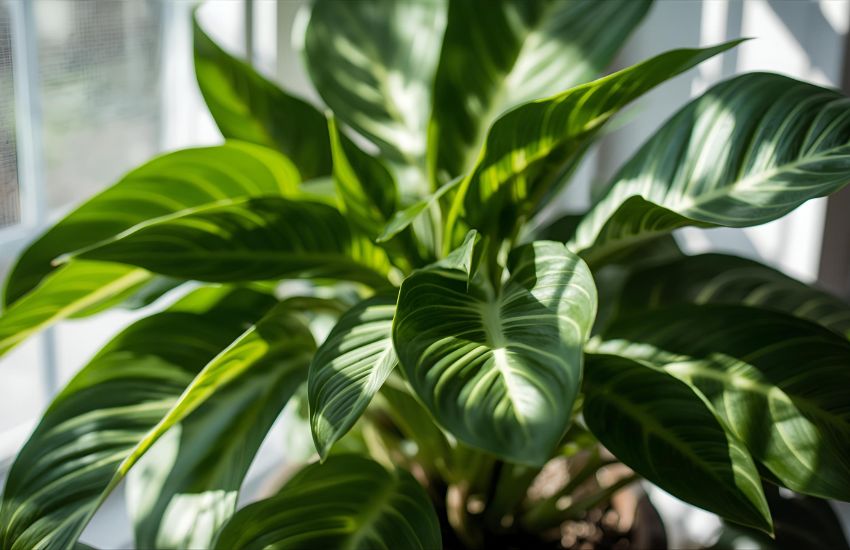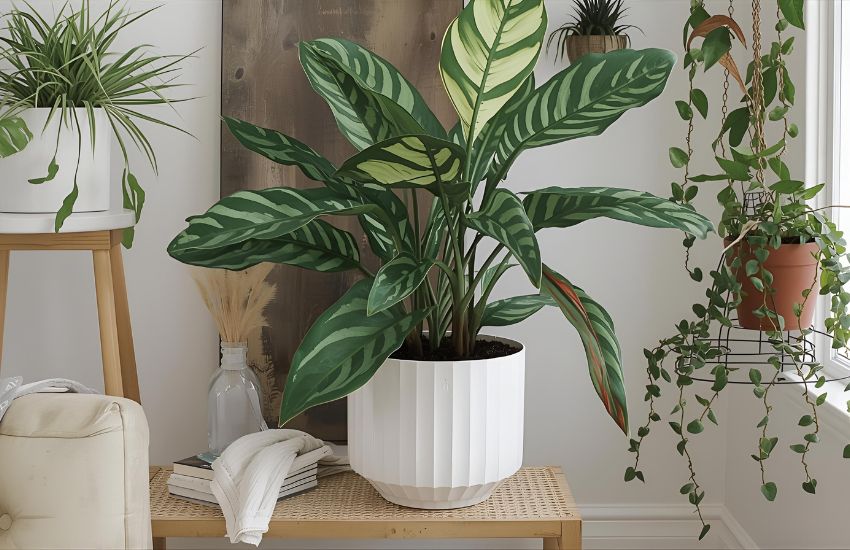Looking for a striking indoor plant that blends elegance with easy-care charm? The Calathea Burle Marxii, also known as the Fishbone Prayer Plant, may be just what your space needs. Its distinctive green leaves with bold, herringbone-like patterns make it a standout addition to any plant collection. What’s more, this prayer plant is non-toxic, making it safe for homes with pets or children.
The Calathea Burle Marxii, or Fishbone Prayer Plant, thrives in indirect light, high humidity, and well-draining soil. Water thoroughly but avoid soggy conditions. This low-growing variety features striking green tiger stripes and purple undersides. Perfect for low-light situations, it adds a bold tropical touch indoors. Keep away from direct light to prevent leaf scorch.
In this guide, you’ll discover everything you need to grow and maintain your Calathea Fishbone or Ctenanthe Burle-Marxii indoors. From choosing the right pot and positioning it for ideal indirect light, to managing pests, watering routines, and how often to fertilize, this complete care guide ensures your Burle Marx thrives with grace.
Calathea Burle Marxii Plant Care Tips for Fishbone Prayer Plant

- The Calathea Burle Marxii, known by the nickname “prayer plant”, belongs to the marantaceae family and is admired for its icy-blue leaves with dark green herringbone markings—making the fishbone resembles a fish skeleton.
- These low-growing tropical plants naturally thrive growing underneath canopies in rainforests, where they receive filtered sunlight and high humidity.
- A defining trait of this plant is how its leaves raise at night and lower during the day. This rhythmic movement gives it the popular “prayer plant” name, as leaves direct the plant’s position toward or away from light.
- Place the plant in a spot with medium to bright indirect light. It can also thrive with fluorescent lighting, but avoid direct sun exposure, which can damage the leaves.
- These plants can be sensitive to water quality. Avoid tap water due to harsh chemicals in tap water. It’s recommended to use distilled or rain water to avoid burned edges on the leaves.
- Water consistently to keep the soil lightly moist, but not soggy. Overwatering may lead to root rot, while dry conditions may cause leaf curl.
- Use a balanced houseplant fertilizer during the growing season to support new leaves and overall plant health.
- As part of regular calathea plant care, remove any yellow leaves to keep the plant looking its best and to prevent disease spread.
- This Calathea Burle Marx is a statement houseplant with leaves with dark green tiger stripes that demands attention while being safe and non-toxic for pets and children.
How to Keep Calathea Plants Thriving with Proper Humidity Levels

Maintaining optimal humidity is one of the most important aspects of keeping your Calathea plants healthy and vibrant. These tropical beauties, including varieties like rattlesnake plants and the stunning Calathea Burle Marxii, naturally grow in humid, shaded rainforests. As a result, replicating that environment indoors is essential for their long-term well-being.
Why Humidity Matters for Calathea Health
Calatheas have thin, delicate foliage that is sensitive to dry indoor air. Without sufficient humidity, the edges of the leaves may brown or curl, and you may notice a general loss of vibrancy. When humidity is right, you’ll enjoy lush growth and the full expression of their eye-catching patterns. For instance, in the Calathea Burle Marxii, the pattern on the fishbone resembles a herringbone or fish skeleton, with bold dark and light green leaves. To maintain this detail, high humidity—ideally around 50–70%—is key.
Practical Ways to Increase Humidity Indoors
There are several methods to maintain the humidity levels your Calathea needs:
- Use a humidifier: This is the most reliable option for consistent humidity, especially in dry climates or winter months.
- Group plants together: Calatheas enjoy the collective moisture released by neighboring plants.
- Pebble trays with water: Place the plant pot on a tray filled with pebbles and water, ensuring the pot doesn’t sit directly in the water.
- Regular misting: Light misting can provide a temporary boost, but should not be the only method.
Supporting Humidity with Proper Setup
Aside from humidity, other care factors help your Calathea thrive. Ensure the plant is in a pot with a drainage hole to avoid soggy roots, and use rich, well-aerated potting soil that retains moisture without waterlogging. Provide indirect bright light, as Calatheas are happy with indirect bright light and can suffer under direct sun.
Feed the plant with a balanced liquid fertilizer every 4–6 weeks during the growing season, but avoid overfeeding, especially if old leaves begin yellowing or dropping—a possible sign of nutrient buildup.
Conclusion
In conclusion, the Calathea Burle Marxii is a stunning low-growing variety that rewards careful attention with uniquely patterned foliage—green tiger stripes and purple hues on the undersides of its leaves. Whether you’re drawn to the dramatic tiger stripes and purple undersides or its gentle leaf movements, this tropical houseplant thrives when you provide the right balance of humidity, filtered light, and care. While it is happy in low-light situations, always protect it from harsh direct light to preserve its vibrant colors and prevent leaf damage.
To support healthy roots and avoid issues like spider mites or rot, ensure excellent aeration in the soil, and always water thoroughly, allowing excess water to drain freely. Keep an eye out for yellow leaves to direct your attention to possible care adjustments—whether that’s watering, lighting, or humidity.
If you’re ready to elevate your indoor plant collection with a striking yet sensitive showpiece, the Calathea Burle Marxii offers beauty, rhythm, and character. Start today by applying these expert tips and transform your space into a thriving tropical retreat. Explore more care guides, and bring your Calathea’s full potential to life!
Frequently Asked Questions (Calathea Burle Marxii Plant: Complete Care Guide for the Fishbone Prayer Plant Indoors)
How do you care for a Calathea fishbone plant?
The Calathea fishbone plant thrives in bright, indirect light and prefers consistently moist, well-draining soil. Keep humidity high by misting or using a humidifier, as dry air can cause leaf edges to brown. Water with filtered or distilled water to avoid leaf damage. Maintain temperatures between 18–26°C and fertilize monthly during the growing season.
How to take care of Burle Marxii?
Calathea Burle Marxii thrives in bright, indirect light and high humidity. Keep soil consistently moist but not soggy, using well-draining mix. Water with filtered or distilled water to avoid leaf damage. Maintain temperatures between 18–27°C and mist regularly. Fertilize monthly during growing season with balanced liquid fertilizer. Avoid direct sunlight and cold drafts.
How do you care for a fishbone Prayer Plant indoors?
The Fishbone Prayer Plant (Ctenanthe burle-marxii) thrives indoors with bright, indirect light and consistent moisture. Keep soil slightly damp but not soggy, using well-draining potting mix. Maintain high humidity and temperatures between 18–27°C. Mist regularly or use a humidifier. Fertilize monthly in spring and summer. Avoid cold drafts and direct sunlight to prevent leaf damage.
How to take care of a Calathea Prayer Plant?
A Calathea Prayer Plant thrives in bright, indirect light with high humidity. Keep soil consistently moist but not soggy, using filtered or distilled water to avoid leaf damage. Maintain temperatures between 18–27°C and mist regularly. Fertilize monthly in spring and summer with diluted fertilizer. Avoid drafts, as Calatheas are sensitive to sudden temperature changes.
